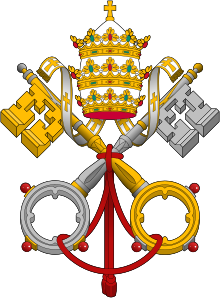Introduction The Catholic Church, also known as the Roman Catholic Church, is the largest Christian church, with 1.28 to 1.39 billion baptized Catholics worldwide as of 2024. It is among the world's oldest and largest international institutions and has played a prominent role in the history and development of Western civilization. The church consists of 24 sui iuris churches, including the Latin Church and 23 Eastern Catholic Churches, which comprise almost 3,500 dioceses and eparchies around the world. The pope, who is the bishop of Rome, is the chief pastor of the church. The Diocese of Rome, known as the Holy See, is the central governing authority of the church. The administrative body of the Holy See, the Roman Curia, has its principal offices in Vatican City, which is a small, independent city-state and enclave within the city of Rome, of which the pope is head of state and absolute elective monarch. The core beliefs of Catholicism are found in the Nicene Creed. The Catholic Church teaches that it is the one, holy, catholic and apostolic church founded by Jesus Christ in his Great Commission, that its bishops are the successors of Christ's apostles, and that the pope is the successor to Saint Peter, upon whom primacy was conferred by Jesus Christ. It maintains that it practises the original Christian faith taught by the apostles, preserving the faith infallibly through scripture and sacred tradition as authentically interpreted through the magisterium of the church. The Roman Rite and others of the Latin Church, the Eastern Catholic liturgies, and institutes such as mendicant orders, enclosed monastic orders and third orders reflect a variety of theological and spiritual emphases in the church. Of its seven sacraments, the Eucharist is the principal one, celebrated liturgically in the Mass. The church teaches that through consecration by a priest, the sacrificial bread and wine become the body and blood of Christ. The Virgin Mary is venerated as the Perpetual Virgin, Mother of God, and Queen of Heaven; she is honoured in dogmas and devotions. Catholic social teaching emphasizes voluntary support for the sick, the poor, and the afflicted through the corporal and spiritual works of mercy. The Catholic Church operates tens of thousands of Catholic schools, universities and colleges, hospitals, and orphanages around the world, and is the largest non-government provider of education and health care in the world. Among its other social services are numerous charitable and humanitarian organizations. (Full article...) Selected article
 The English Reformation was the series of events in 16th century England by which the Church of England broke away from the authority of the Pope and the Roman Catholic Church.These events were part of a wider process, the European Protestant Reformation, a religious and political movement which affected the practice of Christianity across the whole of Europe during this period. Many factors contributed to the ferment: the decline of feudalism and the rise of nationalism, the rise of the common law, the invention of the printing press and increased circulation of the Bible texts, the transmission of new knowledge and ideas not only amongst scholars but amongst merchants and artisans also; but the story of why and how the different states of Europe adhered to different forms of Protestantism, or remained faithful to Rome or allowed different regions within states to come to different conclusions (as they did) is specific to each state and the causes are not agreed.
Selected image
 Credit:Click picture for information 6th century mosaic in Ravenna portrays Jesus dressed as a philosopher king in a cloak of Tyrian purple. He appears as the Pantokrator enthroned as in the Book of Revelation, with the characteristic Christian cross inscribed in the halo behind his head. Selected biography
 Hubert Walter (circa 1160–July 13, 1205) was Chief Justiciar of England and Archbishop of Canterbury in the late twelfth and early thirteenth centuries. He owed his early advancement to his uncle Ranulf de Glanvill, who helped him become a clerk in the Exchequer. Walter served King Henry II of England in many different ways, not only in the financial administration. After an unsuccessful candidacy to the see of York, Walter was elected Bishop of Salisbury shortly after the ascension of King Henry's son Richard I to the throne of England. Walter accompanied King Richard on the Third Crusade and was one of the principal persons involved in raising Richard's ransom after the king had been captured in Germany while returning home from Crusade. As a reward for his faithful service, Walter was selected to become the next Archbishop of Canterbury in 1193. Walter also served as justiciar for Richard until 1198.
Did you know...
Related portalsFeast Day of February 26
Selected quote
News
SubcategoriesTopics
The Holy Bible:
Particular Churches (grouped by liturgical rite):
Things you can do
External resourcesWikiProjectsAssociated WikimediaThe following Wikimedia Foundation sister projects provide more on this subject:
Discover Wikipedia using portals |
Värsked postitused
- HÜVA NÕU | Helilogode loojad selgitavad, kuidas on võimalik muusikaga esile kutsuda tugev heaolutunne
- Anekdoot: ma jätsin joomise maha
- Andrei Liimets: “Jan Uuspõld läheb koju” mõjub pastakast välja imetuna
- Kai kunstikeskuses etendub Soome koreograafi Anna Maria Häkkineni tantsulavastus
- Norra suusatäht sai suusaalade MM-i avavõistluse eel vigastada










































